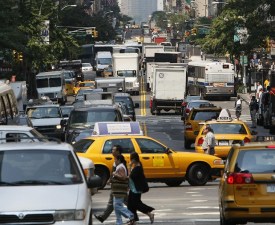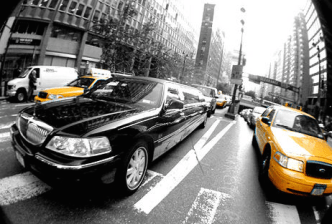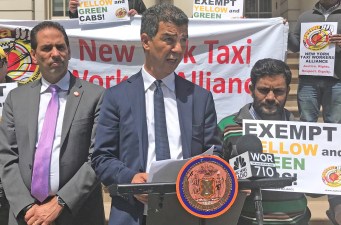A Flat “Congestion Charge” for Taxis and Uber: Yea or Nay?
Would a new surcharge on taxi and for-hire vehicle trips in Manhattan below 59th Street thin out traffic on congested streets? Not much it won’t, according to transportation economist Charles Komanoff, whose traffic analysis has helped shape the Move NY toll reform campaign.

Every year the city’s Independent Budget Office releases a list of options to cut expenses and raise revenue for the city budget [PDF]. This year, the IBO suggests a surcharge of $2.25 for taxi trips and $2.75 for FHV trips beginning below 59th Street (page 88). The difference makes up for the $0.50 surcharge earmarked for the MTA that’s currently levied only on taxi rides.
The IBO’s taxi surcharge idea comes at an intriguing moment. The de Blasio administration is currently finalizing its report on the effect of Uber, Lyft, and other app-based car services on Manhattan congestion. And the Move NY plan still has an opening in Albany in the next few months, as Governor Cuomo and the state legislature search for ways to pay for the MTA capital program and upstate roads and bridges.
On the surface, the surcharge proposal seems to have some appeal. Implementing the fee only for trips starting in the traffic-choked central business district could hypothetically ease congestion by spreading taxi and FHV traffic outward. And adding an MTA surcharge on Uber, Lyft, and similar services could help make up for the $10 million in annual revenue the agency says it has lost due to the rise of e-hail apps.
But Komanoff says a flat surcharge, as opposed to one based on trip length, won’t do much as a traffic reduction strategy, because it privileges long rides over short ones, which would be “both unfair and inefficient.” In addition, a taxi/FHV charge alone, without broader toll reform, would have a marginal effect on congestion. Komanoff put the IBO’s proposal to the test in his Balanced Transportation Analyzer and found that a $2.25 surcharge on taxis would lead to a 1.4 percent increase in traffic speeds — and a 1.8 percent decrease in FHV usage.
A surcharge, preferably tied to the length of a trip, would make much more sense within the context of the Move NY toll reform plan, which would put a price on the free East River bridges and driving across 60th Street into downtown Manhattan, while reducing tolls on outlying crossings. “That would thin out traffic within the CBD sufficiently to generate more fares per hour (benefiting drivers) and speed trips (benefiting passengers) — enough to more than offset the added direct cost of the surcharge,” Komanoff said.
The IBO does suggest bridge tolling, but not the Move NY plan. Instead, it proposes a one-way toll of $11.08 on East River bridges and $5.08 on Harlem River bridges. Moving the northern cordon from 60th Street to the Harlem River, however, would both yield less revenue and shift the burden to outer borough residents, going against the political imperatives that Move NY has tried to follow.
Move NY’s Alex Matthiessen commended the IBO’s focus on addressing gridlock, but questioned “why they’re trying to reinvent the wheel.”



